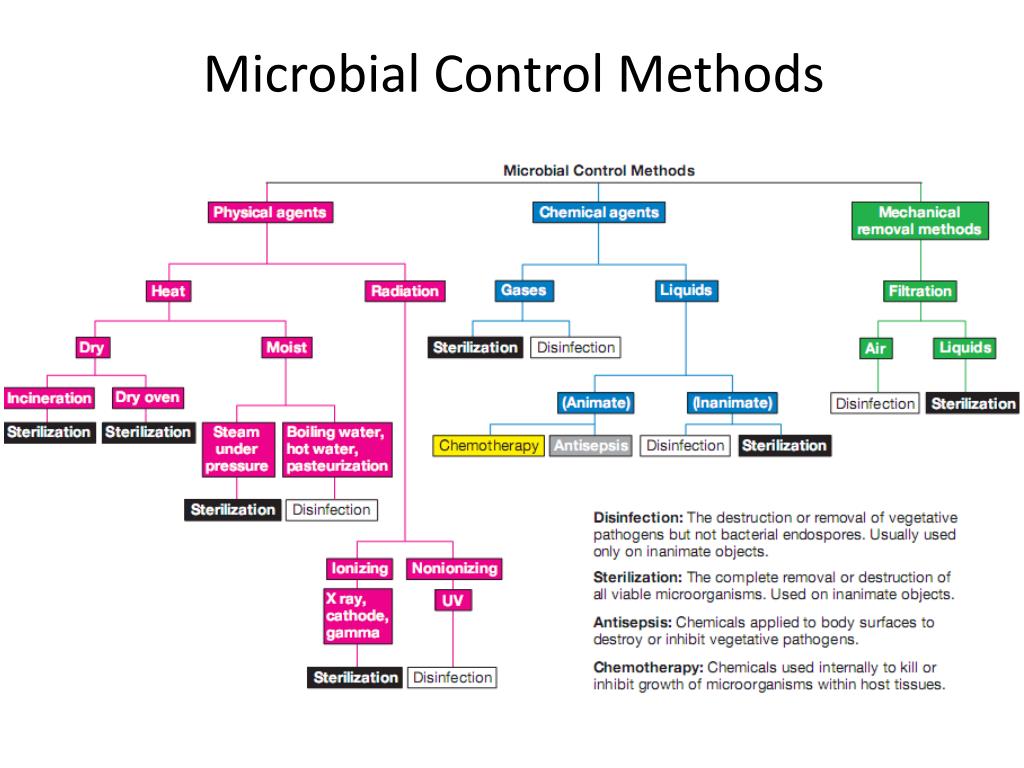Microorganisms can cause diseases, spoil food, and contaminate laboratory samples. To control microorganisms, physical, chemical, and biological methods are used. Physical methods include heat, radiation, and filtration. Chemical methods include disinfectants, antiseptics, and antibiotics. Biological methods include beneficial microorganisms, such as probiotics, and bacteriophages. Overall, controlling microorganisms is crucial to ensure accurate research, safe food and water, and disease prevention. This article focuses different techniques of control of microorganisms. We will discuss definitions of a) Sterilization b) Disinfection c) Antiseptic d) Germicide e) Microbiostasis, f) Antisepsis g) Sanitization.

What is Sterilization ?
Sterilization is the process of eliminating or killing all forms of microorganisms, including bacteria, viruses, fungi, and spores, from a surface, object, or substance.
- Sterilization eliminates or kills all forms of microorganisms
- Physical methods like heat or radiation, or chemical methods using sterilizing agents achieve sterilization
- Sterilization is important in healthcare and food production to prevent contamination and ensure safety
What is Disinfection ?
Disinfection is the process of reducing or eliminating harmful microorganisms from surfaces, objects, or substances, typically using chemical agents
- Disinfection reduces or eliminates harmful microorganisms from surfaces or objects
- Chemical agents, such as disinfectants, are used for disinfection
- The goal of disinfection is to reduce the risk of disease transmission
What is Antiseptic ?
Antiseptic is a substance that can inhibit or destroy the growth of microorganisms, such as bacteria, viruses, and fungi, on living tissues or surfaces
- Rubbing alcohol is an antiseptic for cleaning wounds.
- Chlorhexidine is an antiseptic for cleaning surgical instruments and to prepare the skin before surgery.
- Betadine is an antiseptic solution for disinfecting skin before medical procedures or to treat minor cuts and abrasions.
- Hydrogen peroxide is a common antiseptic for cleaning cuts and wounds.
- Tea tree oil is a natural antiseptic for treating acne or other skin conditions.
- Bacitracin is an antibiotic ointment that also has antiseptic properties and is commonly used to prevent infections in cuts and burns.
What is Germicide?
Germicide is a substance that kills or gets rid of microorganisms like bacteria, viruses, and fungi.
- It is commonly used in places like hospitals and labs to prevent the spread of diseases.
- Germicides work by breaking down the cells of the microorganisms, which kills them.
- You can use germicides on things like equipment, surfaces, and instruments to make sure they’re clean and safe to use.
- But it’s important to follow safety rules when using germicides to avoid any problems.
What is Bacteriostasis ?
It is the condition where bacterial growth is prevented without necessarily killing them,
- Bacteriostasis prevents bacterial growth without killing them
- Fungistatic agents stop the growth of fungi, such as sodium benzoate and potassium sorbate
- Microbiostatic agents collectively inhibit the growth of microorganisms, including bacteria and fungi
- Examples of bacteriostatic agents include tetracyclines, macrolides, clindamycin, trimethoprim/sulfamethoxazole, linezolid, and chloramphenicol.
What is Antisepsis ?
Antisepsis refers to the process of preventing or inhibiting the growth and reproduction of microorganisms on living tissues or surfaces.
- Antisepsis uses chemical agents, known as antiseptics, to kill or inhibit the growth of microorganisms such as bacteria, viruses, and fungi on living tissues or surfaces.
- Medical professionals commonly use antisepsis in settings such as surgical procedures to prevent infections from occurring.
What is Sanitisation?
It is a process that helps to reduce the number of microorganisms on surfaces, objects, or substances to a safe level, but doesn’t necessarily kill all of them.
- Sanitization reduces microorganisms to safe levels for human contact
- Chlorine and quaternary ammonium compounds are common sanitizing agents
- Sanitization involves physical cleaning with soap and water, followed by sanitizing agents
- Important in food preparation to prevent foodborne illnesses
- Used in water treatment to kill harmful microorganisms in drinking water
- Not as effective as sterilization or disinfection, but still important for preventing the spread of infectious diseases